Microstructure, Mechanical Properties, and Thermal Stability of Carbon-Free High Speed Tool Steel Strengthened by Intermetallics Compared to Vanadis 60 Steel Strengthened by Carbides
Abstract
1. Introduction
2. Materials and Methods
3. Results and Discussion
3.1. Microstructure
3.2. Mechanical Properties
3.3. Thermal Stability
4. Conclusions
Author Contributions
Funding
Institutional Review Board Statement
Informed Consent Statement
Data Availability Statement
Conflicts of Interest
References
- Roberts, G.; Krauss, G.; Kenedy, R. Chapter 14—High speed steel. In Tool Steels, 5th ed.; ASM International: Metals Park, OH, USA, 1998; pp. 251–290. [Google Scholar]
- Højerslev, C. Tool Steels; Forskningscenter Risoe: Roskilde, Denmark, 2001; ISBN 87-550-2833-0. [Google Scholar] [CrossRef]
- Liu, B.; Qin, T.; Xu, W.; Jia, C.; Wu, Q.; Chen, M.; Liu, Z. Effect of Tempering Conditions on Secondary Hardening of Carbides and Retained Austenite in Spray-Formed M42 High-Speed Steel. Materials 2019, 12, 3714. [Google Scholar] [CrossRef]
- Guo, J.; Liao, B.; Liu, L.; Gao, Y.; Ren, J.; Yang, Q. Composition Optimization and Experimental Characterization of a Novel Steel Based on CALPHAD. J. Mater. Eng. Perform. 2015, 24, 2099–2107. [Google Scholar] [CrossRef][Green Version]
- Godec, M.; Balantič, D.A.S. Coarsening behaviour of M23C6 carbides in creep-resistant steel exposed to high temperatures. Sci. Rep. 2016, 6, 29734. [Google Scholar] [CrossRef] [PubMed]
- Nurbanasari, M.; Tsakiropoulos, P.; Palmiere, E. A Study of Carbide Precipitation in a H21 Tool Steel. ISIJ Int. 2014, 54, 1667–1676. [Google Scholar] [CrossRef]
- Brandis, H.; Haberling, E.; Weigand, H.H. Metallkundliche Betrachtung der Carbide in Schnellarbeitsstaehlen; Thyssen Edelstahl Technische Berichte 7. Band; Pascal and Francis Bibliographic Databases: Krefeld, Germany, 1981; Volume 2, pp. 115–122. Available online: http://pascal-francis.inist.fr/vibad/index.php?action=getRecordDetail&idt=PASCAL8300188909 (accessed on 4 September 2021).
- Roberts, G.A.; Cary, R.A. Tool Steels, 4th ed.; ASM: Metals Park, OH, USA, 1980; p. 749. [Google Scholar]
- Chaus, A.S.; Dománková, M. Unknown high-speed steel. Mater. Lett. 2021, 292, 129653. [Google Scholar] [CrossRef]
- VANADIS 60—SuperClean Co-legierter Hochleistungs—PM—Schnellarbeitsstahl, Uddeholm Materials List. Available online: https://www.uddeholm.com/app/uploads/sites/49/2018/11/vanadis-60-eng_p_1904-e10.pdf (accessed on 4 September 2021).
- Köster, W. Mechanische und magnetische Ausscheidungshärtung der Eisen-Kobalt-Wolfram- und Eisen-Kobalt-Molybdän-Legierungen. Archiv Eisenhüttenwesen 1932, 6, 17–23. [Google Scholar] [CrossRef]
- Geller, Y.A.; Zhdanova, F.I.; Imshennik, K.P.; Malinkina, E.I.; Kras’Ko, G.I. Cast precipitation-hardening alloys with high hardness and strength. Tool Steels 1968, 8, 18–22. [Google Scholar] [CrossRef]
- Geller, Y.A.; Kremnev, L.S.; Linnik, V.A. Fe-Ni-Co-Mo Maraging tool steels. Tool Steels Alloy. 1976, 5, 11–14. [Google Scholar] [CrossRef]
- Sha, W.; Leitner, H.; Guo, Z.; Xu, W. Phase transformations in maraging steels. Phase Transform. Steels 2012, 2, 332–362. [Google Scholar]
- Edneral, A.F.; Zhukov, O.P.; Perkas, M.D. Maraging Steels with a stranght over 200 kg/mm2. Met. Sci. Heat Treat. 1971, 4, 9–14. [Google Scholar]
- Edneral, A.F.; Zhukov, O.P.; Perkas, M.D. Effect of Cobalt on Aging of Martensite and Ferrite in Fe-Co-W and Fe-Co-Mo Alloys. Maraging Steels 1974, 10, 24–28. [Google Scholar] [CrossRef]
- Doi, M.; Tanabe, H.; Miyazaki, T. Deveolopment of ultra high strength steels based on spinodal decomposition. J. Mater. Sci. 1987, 22, 1328–1334. [Google Scholar] [CrossRef]
- Miyazaki, T.; Takagishi, S.; Mori, H.; Kozakai, T. The phase decomposition of iron-molybdenum binary alloys by spinodal mechanism. Acta Metall. 1980, 28, 1143–1153. [Google Scholar] [CrossRef]
- Danninger, H.; Rouzbahani, F.; Harold, C.; Ponemayr, H.; Daxelmuller, M.; Simancik, F.; Izdinsky, K. Heat treatment and properties of precipitation hardened carbon-free PM tool steels. Powder Metall. Prog. 2005, 5, 92–103. [Google Scholar]
- Leitner, H.; Schober, M.; Clemens, H.; Caliskanoglu, D.; Danoix, F. Precipitation behaviour of an Fe–Co–Mo-alloy during non-isothermal ageing. Int. J. Mat. Res. 2008, 99, 367–374. [Google Scholar] [CrossRef]
- Eidenberger, E.; Stergar, E.; Leitner, H.; Scheu, C.; Staron, P.; Clemens, H. Precipitates in a Fe-Co-Mo Alloy Characterized by Complementary Methods. Berg Huettenmaenn Mon. 2008, 153, 247–252. [Google Scholar] [CrossRef]
- Eidenberger, E.; Stergar, E.; Leitner, H.; Staron, P.; Spitaler, J.; Ambrosch-Draxl, C.; Clemens, H. Combined use of small-angle neutron scattering and atom probe tomography for the analysis of precipitates in a Fe-15 m% Co-25 m%Mo alloy. Appl. Phys. A 2009, 97, 331–340. [Google Scholar] [CrossRef]
- Eidenberger, E.; Schober, M.; Schmoelzer, T.; Stergar, E.; Staron, P.; Leitner, H.; Clemens, H. Analysis of the multistage phase separation reaction in Fe—25 at% Co—9 at%Mo. Phys. Status Solidi A 2010, 207, 2238–2246. [Google Scholar] [CrossRef]
- Raynor, G.V.; Rivlin, V.G. 15: Critical evaluation of ternary alloys of iron and molybdenum with cobalt, chromium, manganese, and nickel. Int. Met. Rev. 1984, 29, 329–376. [Google Scholar] [CrossRef]
- Radhakrishnan, K.; Prabhu, B.N.; Bharath, R. Suitability of MC90 Intermet material for optimal design of carbon-free broach tool. Mater. Today Proc. 2020, 21, 787–792. [Google Scholar] [CrossRef]
- Bılek, P.; Sobotová, J.; Jurci, P. Evaluation of the microstructural changes in Cr-V ledeburitic tool steel depending on the austenitization temperature. Mater. Technol. 2011, 45, 489. [Google Scholar]
- Baykara, T.; Bedir, H.F. Effects of Heat Treatment on the Mechanical Properties of the Vanadis 4 Extra and Vanadis 10 Tool Steels. J. Mater. Sci. Eng. 2017, 6, 2. [Google Scholar] [CrossRef]
- Jurči, P. Hodnocení struktury plasmově nitrovaných P/M ledeburitických ocelí. In Proceedings of the METAL 2001, Ostrava, Czech Republic, 15–17 May 2001. [Google Scholar]
- Markoli, B.; Spaić, S. Effect of tempering on the microstructure and hardness of ledeburitic chromium steel X155CrVMo12.1. Int. J. Mater. Res. 2007, 98, 150–154. [Google Scholar] [CrossRef]
- Carbides in Vanadis PM Steel. Available online: http://www.steeldata.info/carbides/demo/data/738.html (accessed on 4 September 2021).
- Tool Steels—Tungsten High-Speed Steels. Available online: https://www.azom.com/article.aspx?ArticleID=6136 (accessed on 4 September 2021).
- Conversion Chart of Vickers Hardness (HV) to Rockwell C (HRC). Available online: http://www.taylorspecialsteels.co.uk/pages/main/conchart.htm (accessed on 4 September 2021).
- Šerák, J.; Pečinka, V.; Vojtěch, D. Microstructure of advanced tool steels produced by powder metallurgy. Manuf. Technol. 2018, 18, 821–827. [Google Scholar] [CrossRef]
- Nitta, H.; Yamamoto, T.; Kanno, R.; Takasawa, K.; Iida, T.; Yamazaki, Y.; Ogu, S.; Iijima, Y. Diffusion of molybdenum inα-iron. Acta Mater. 2002, 50, 4117–4125. [Google Scholar] [CrossRef]
- Thibaux, P.; Métenier, A.; Xhoffer, C. Carbon Diffusion Measurement in Austenite in the Temperature Range 500 °C to 900 °C. Metall. Mater. Trans. A 2007, 38A, 1169–1176. [Google Scholar] [CrossRef]
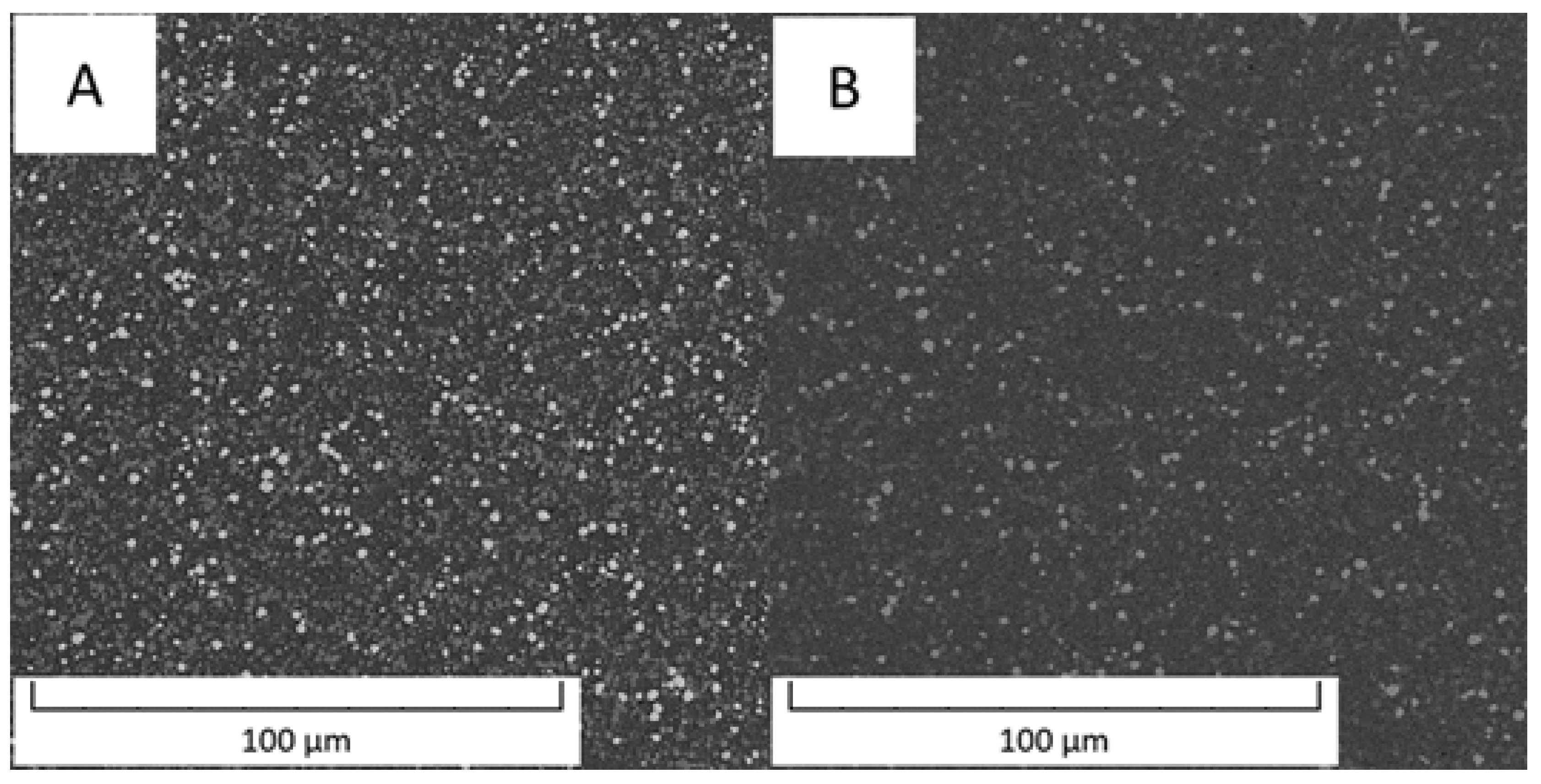
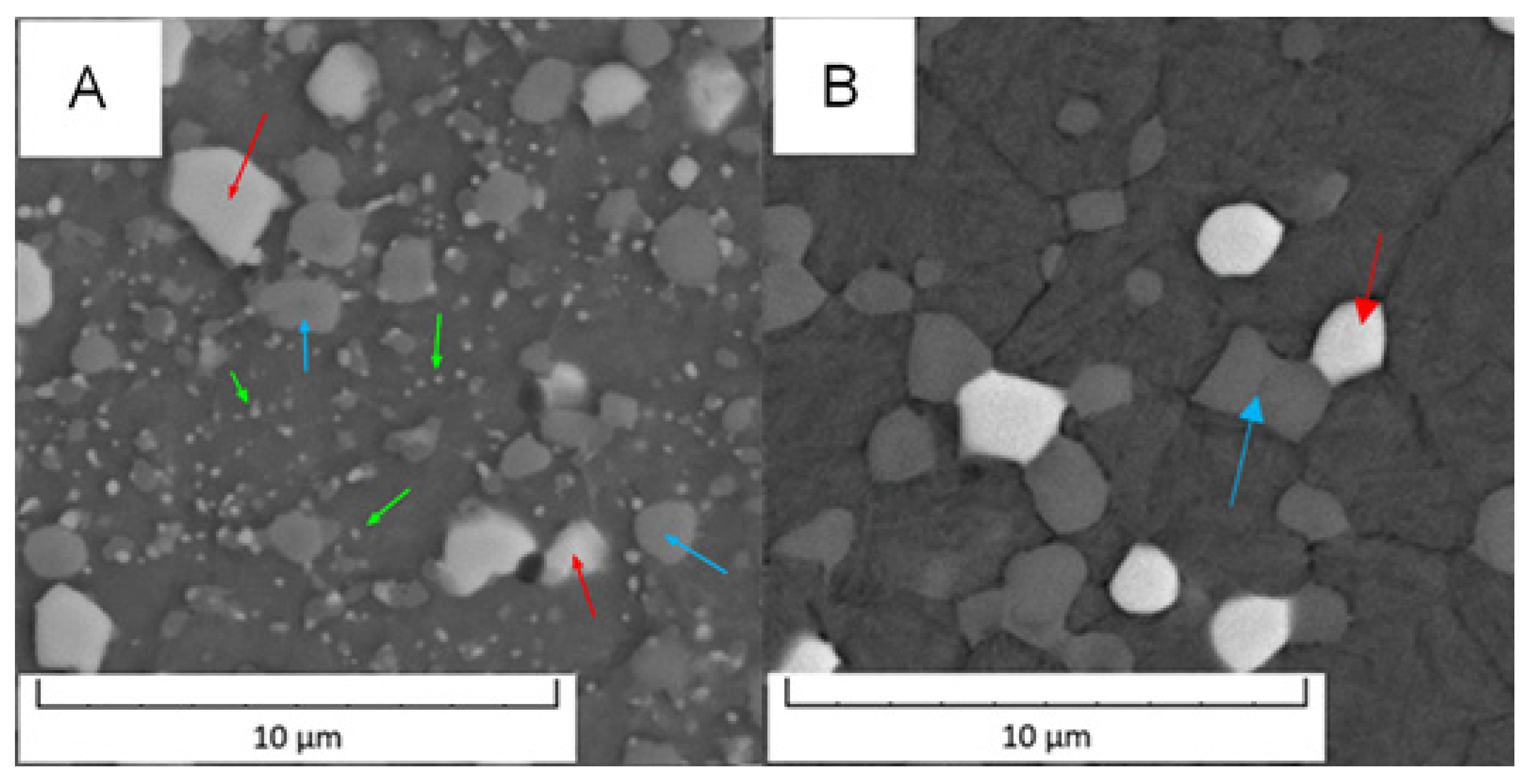
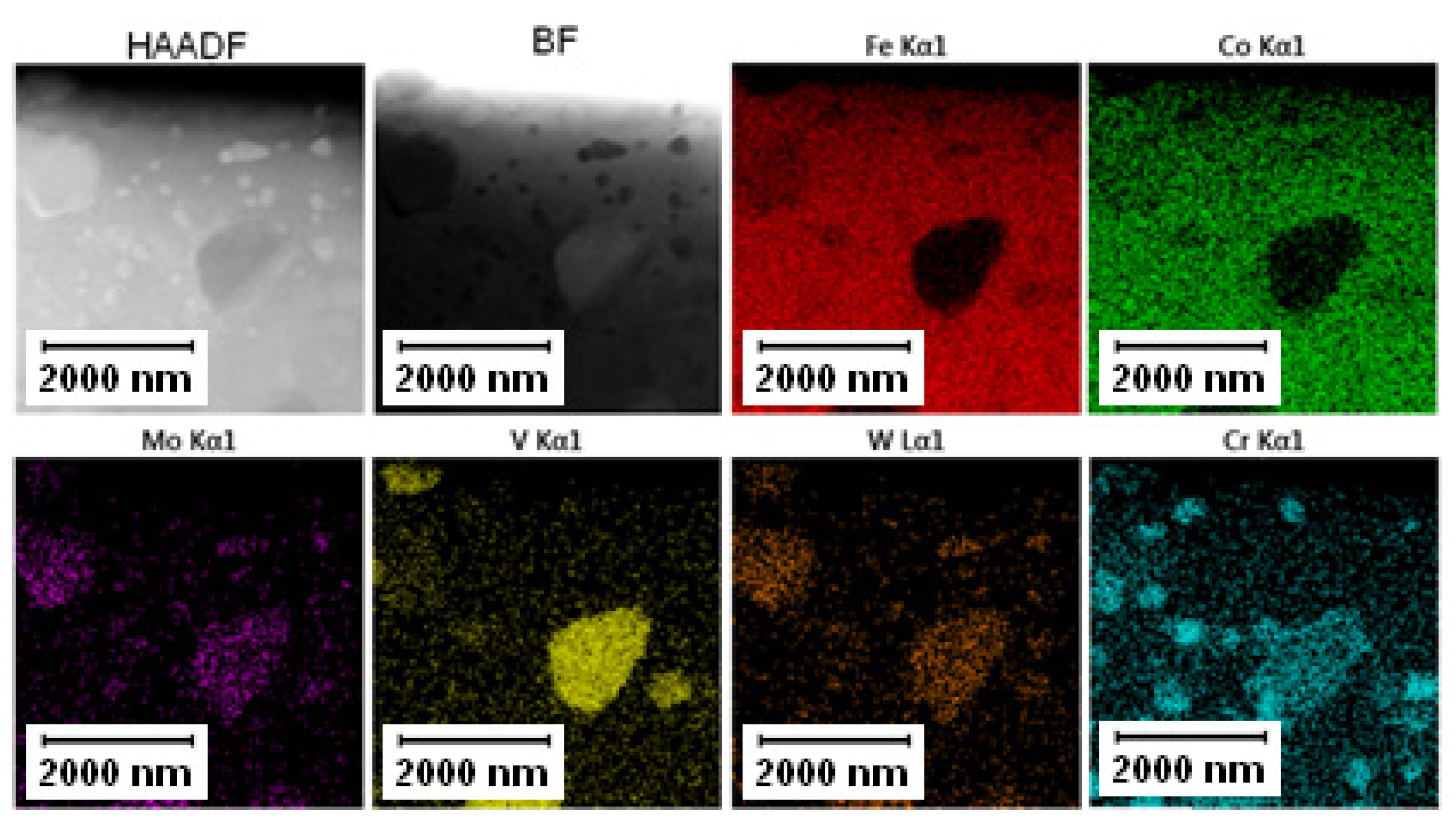
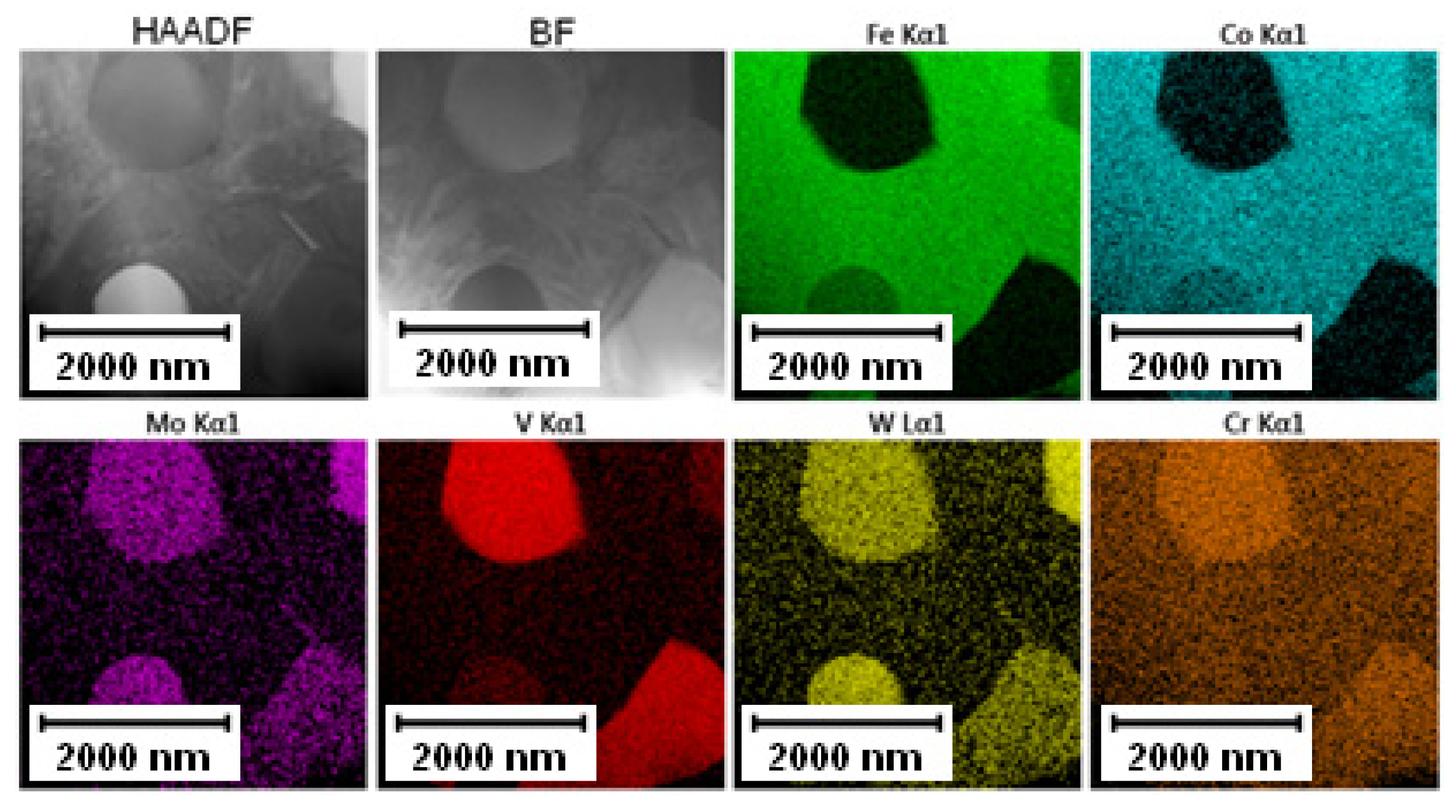

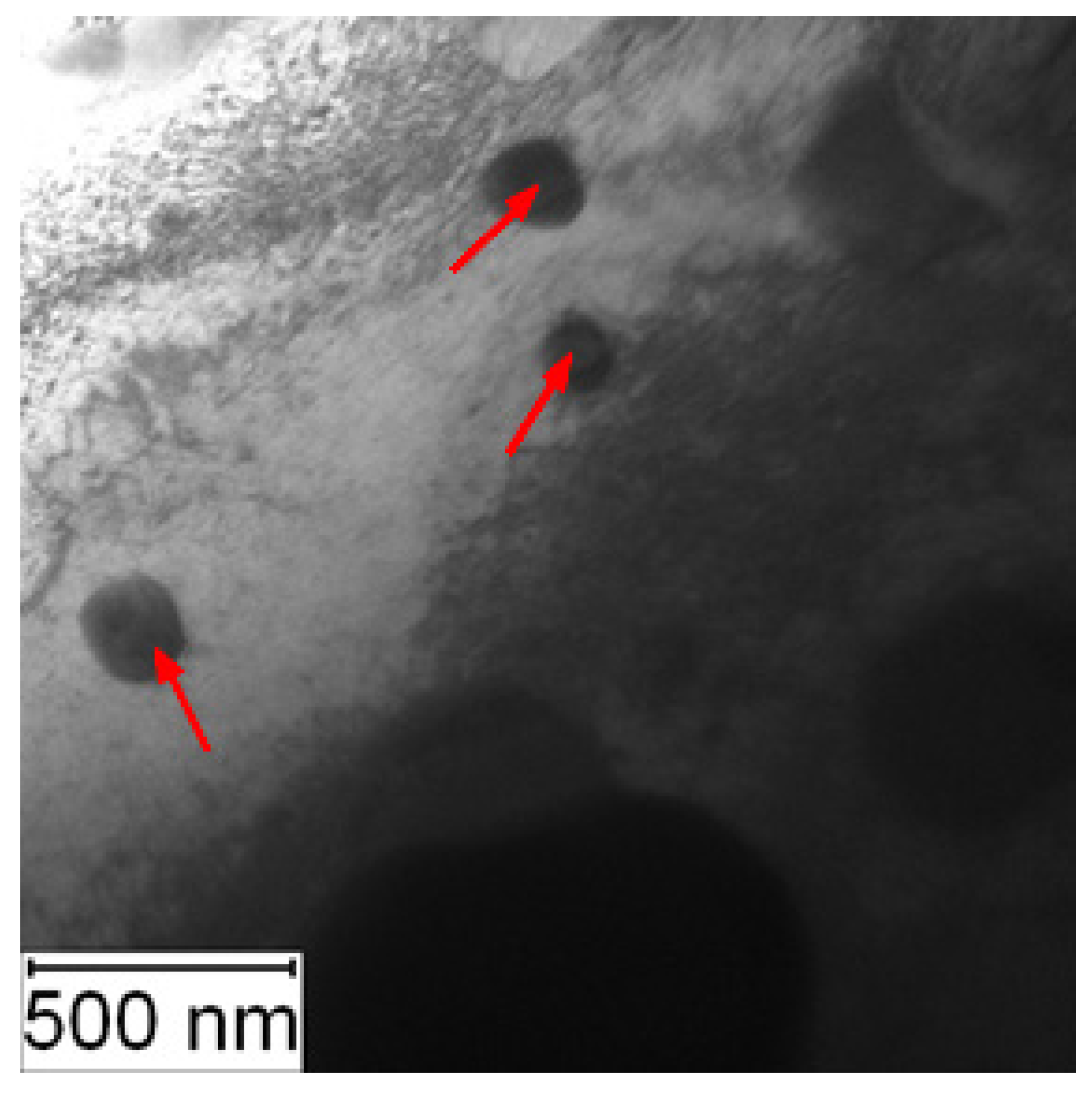
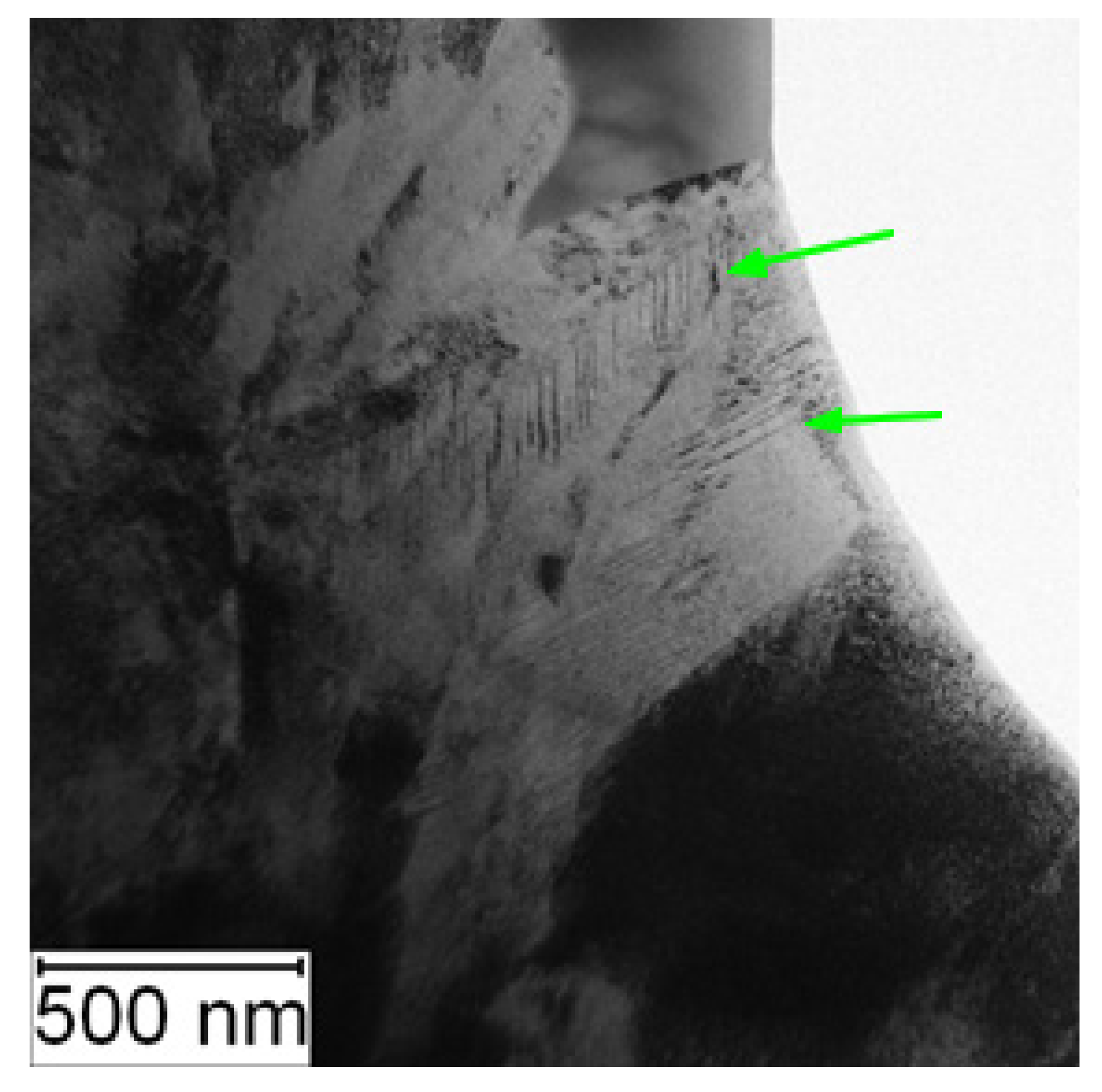

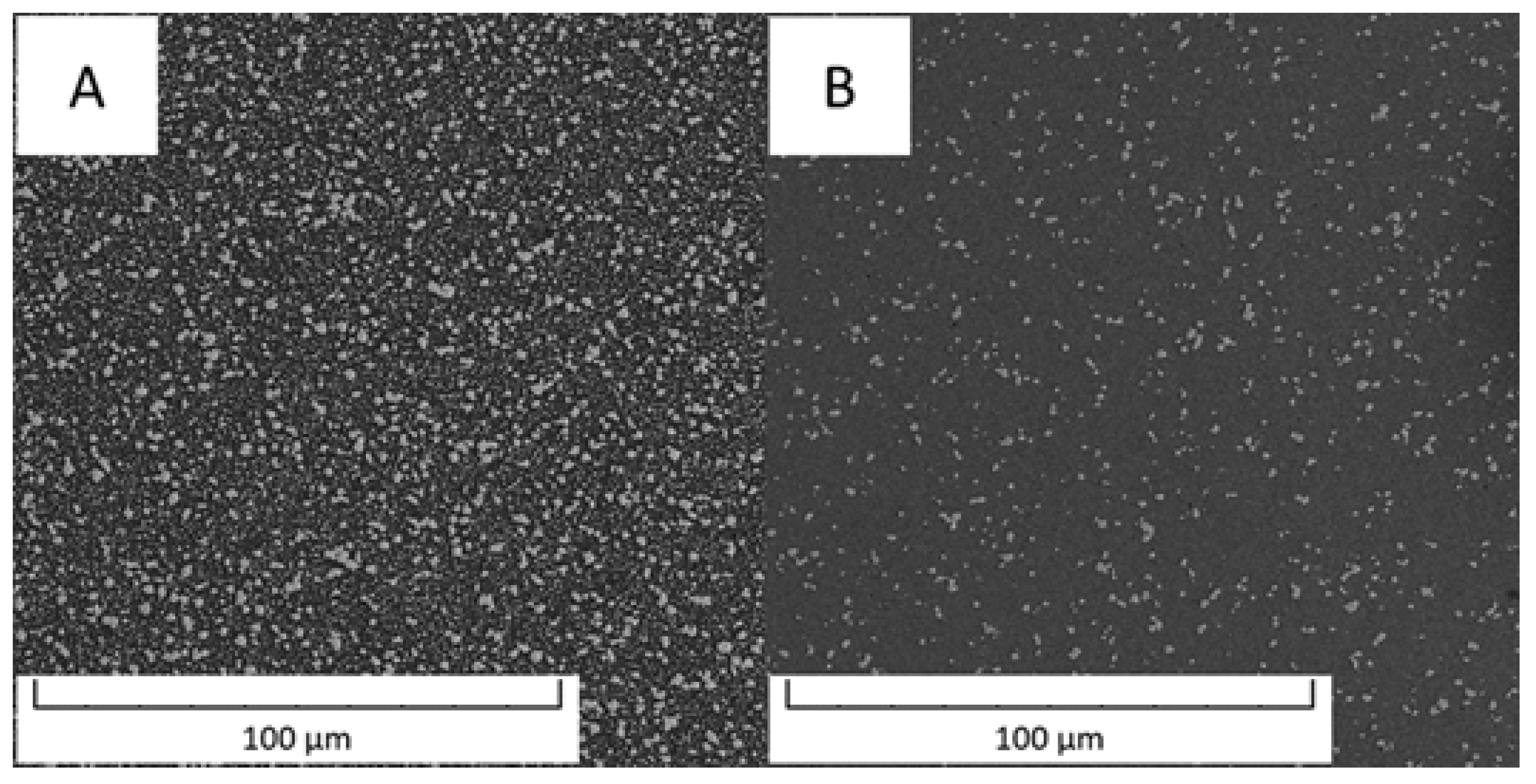
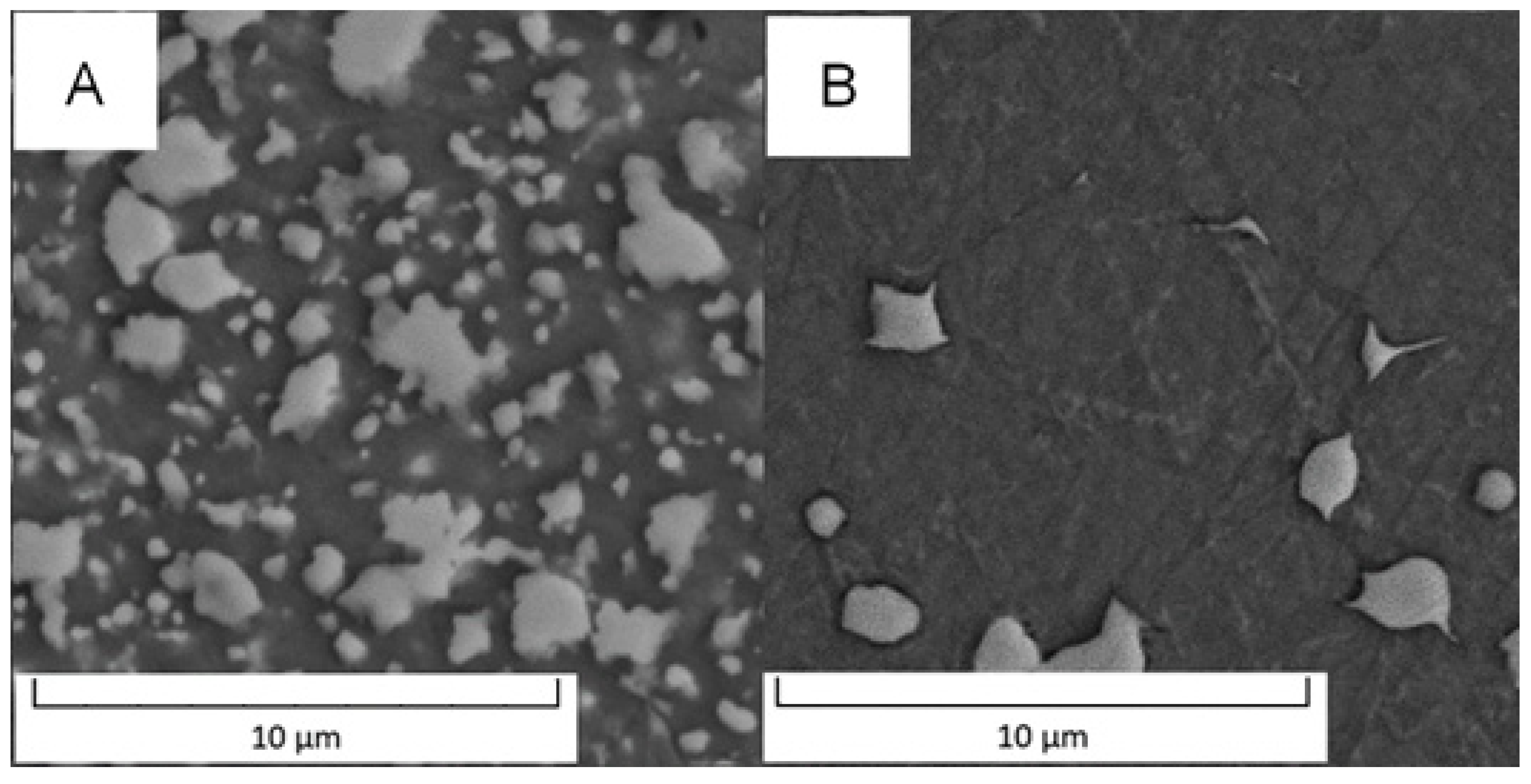
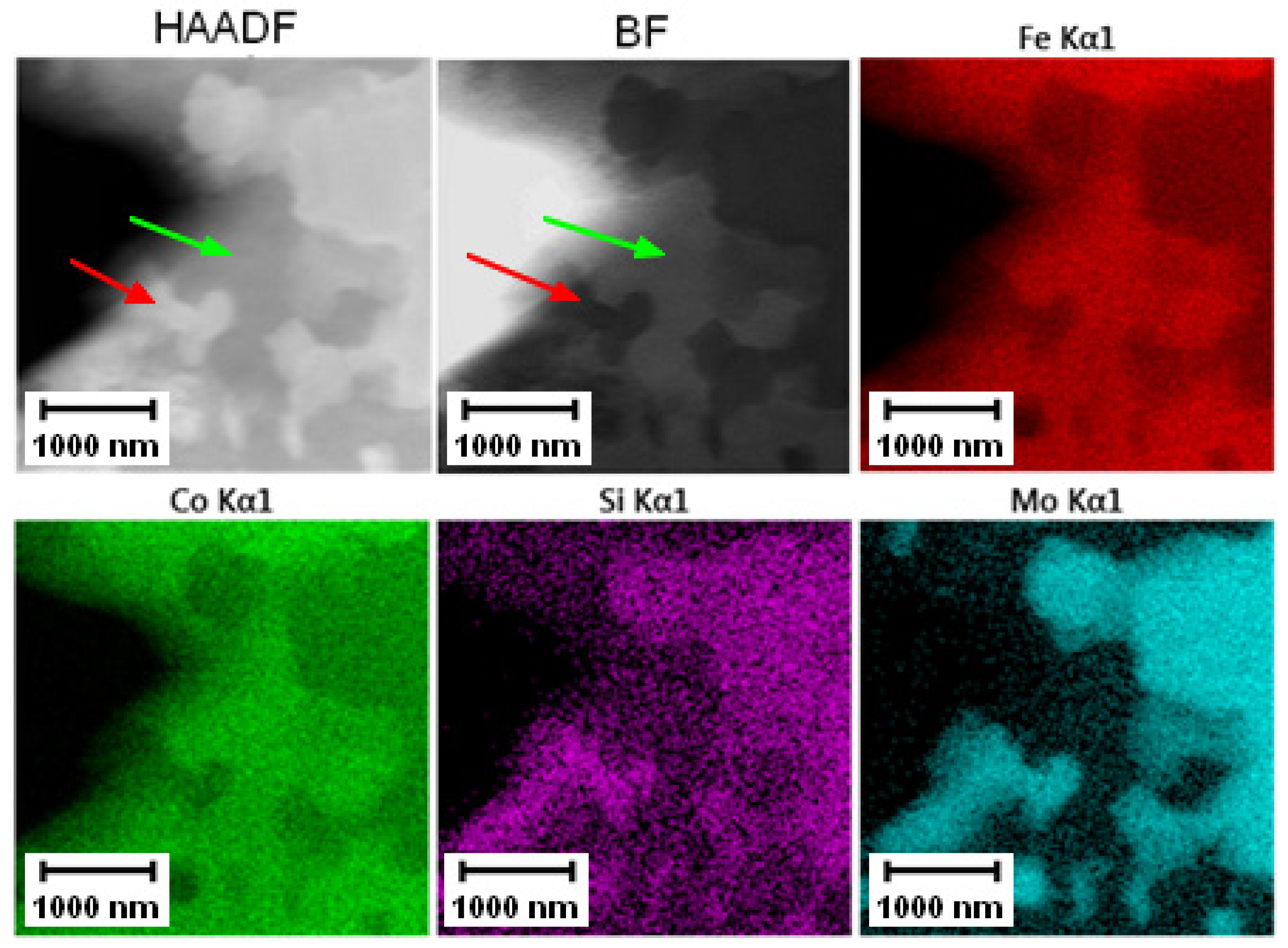
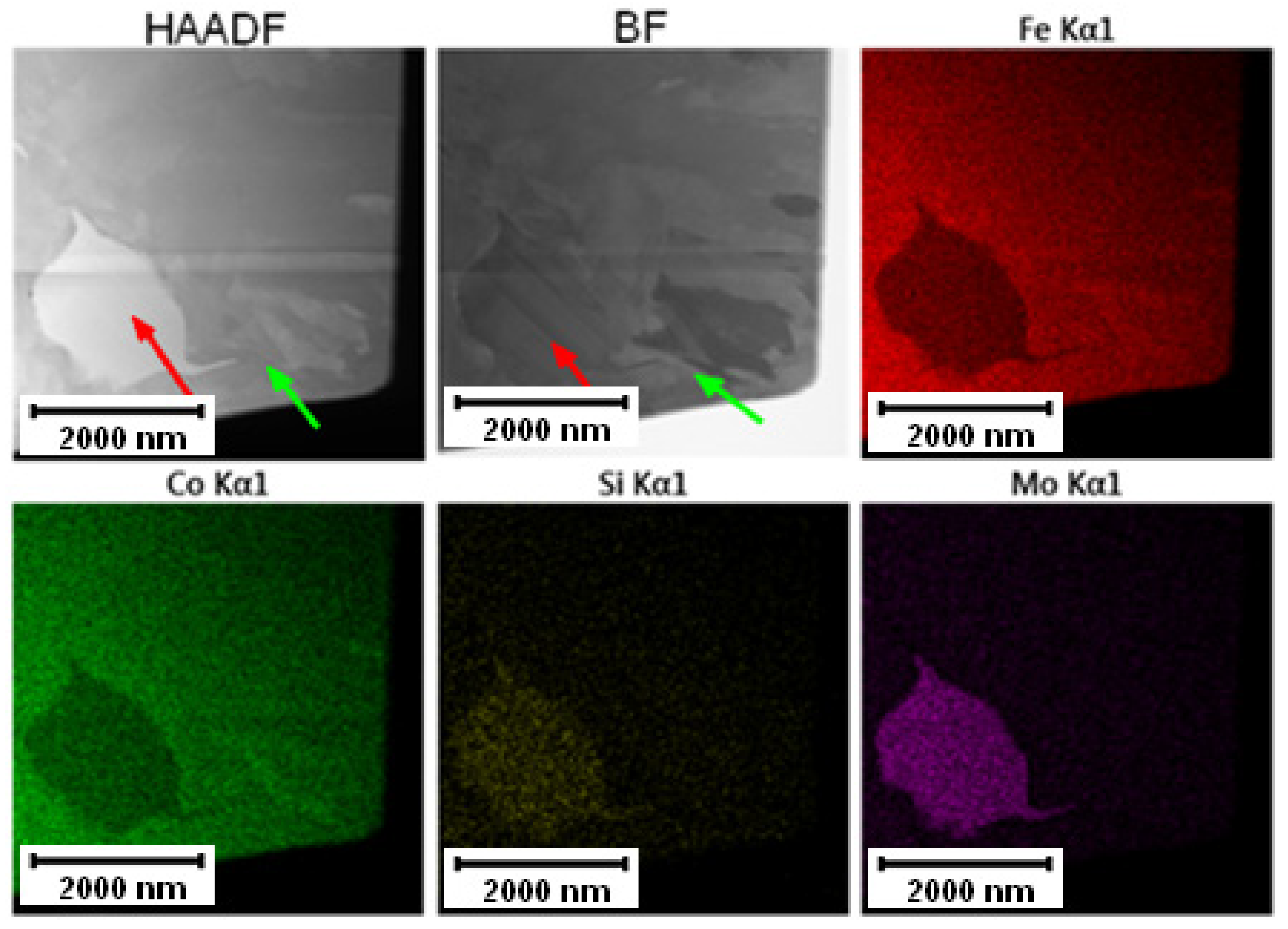
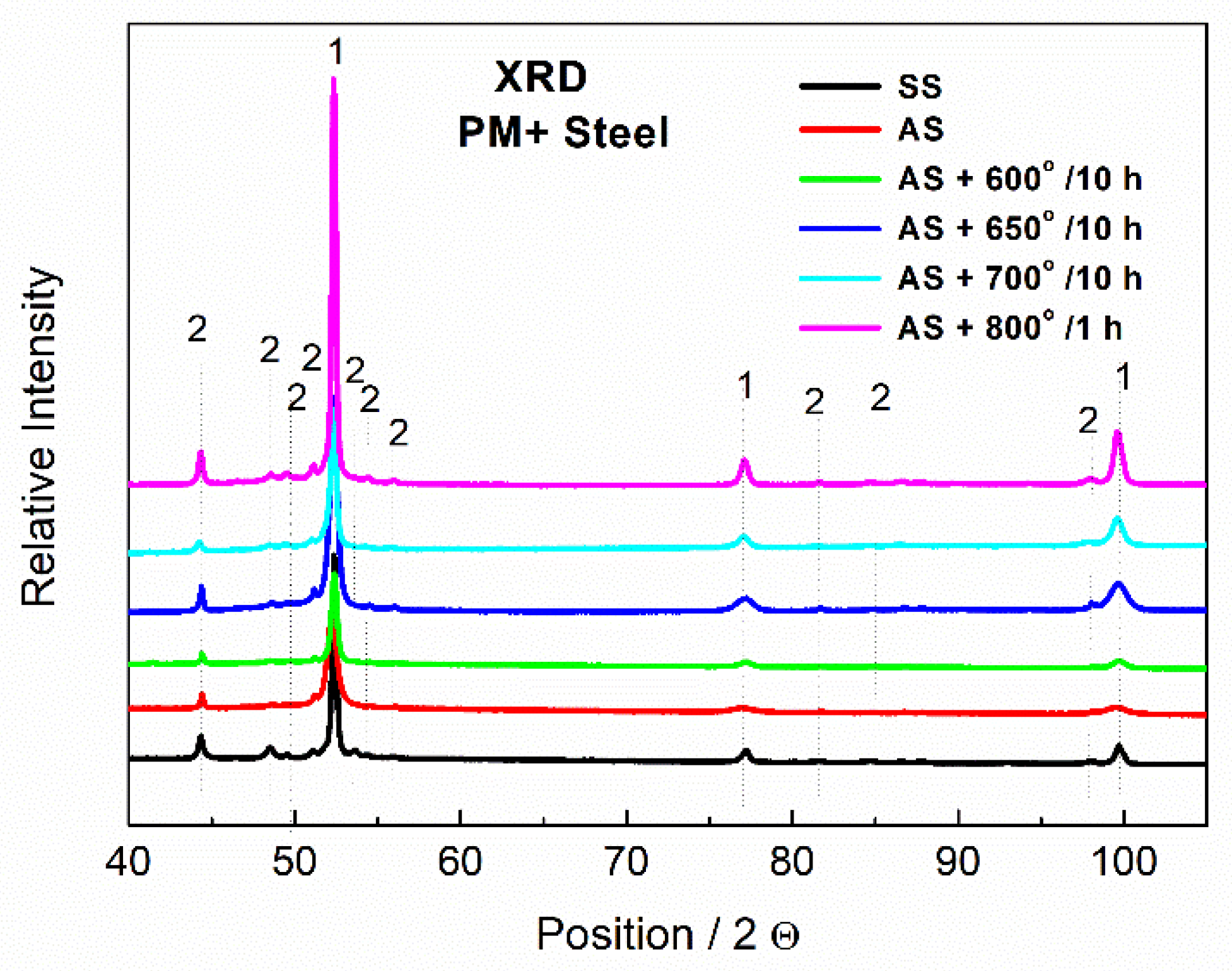


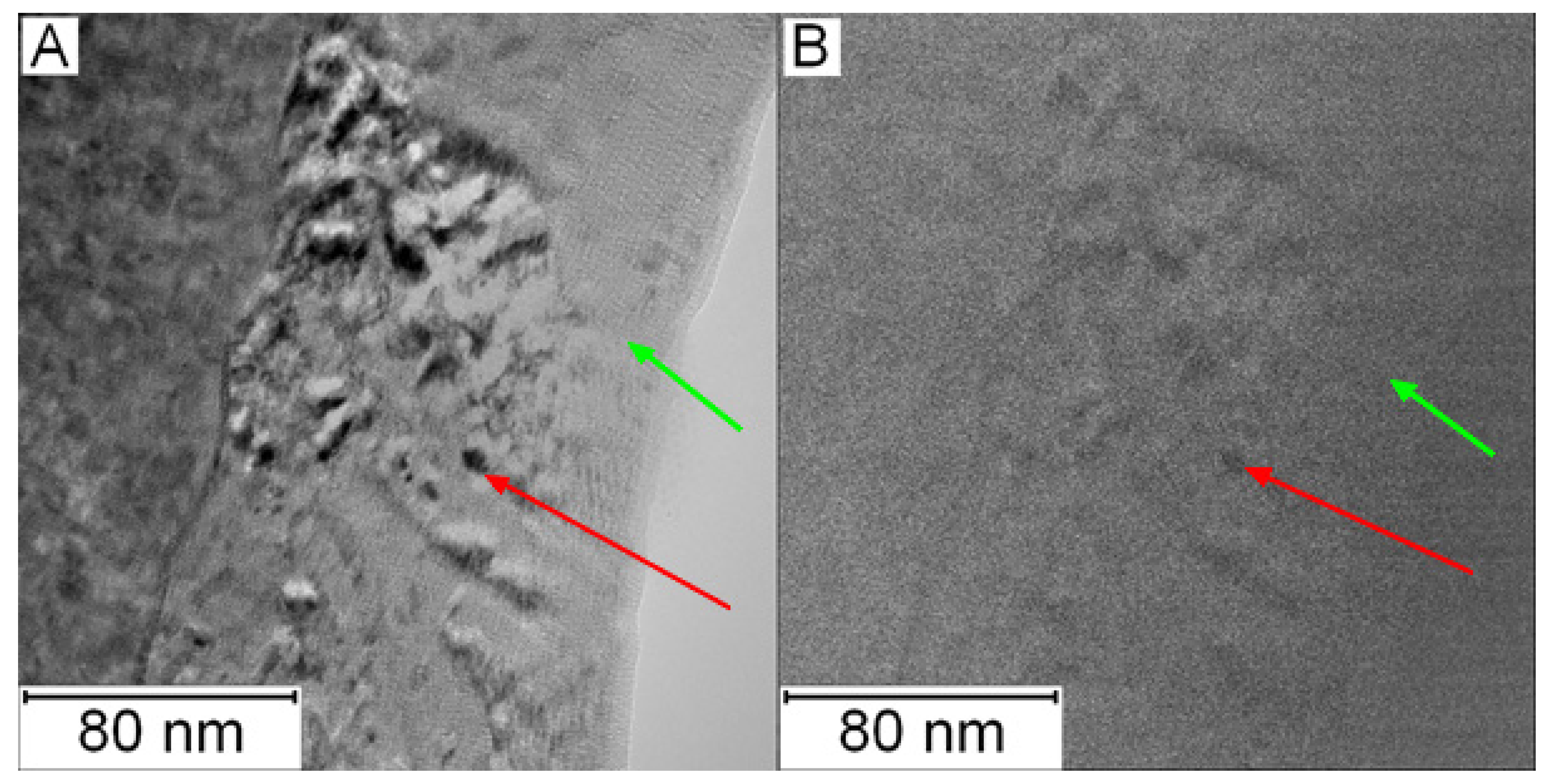

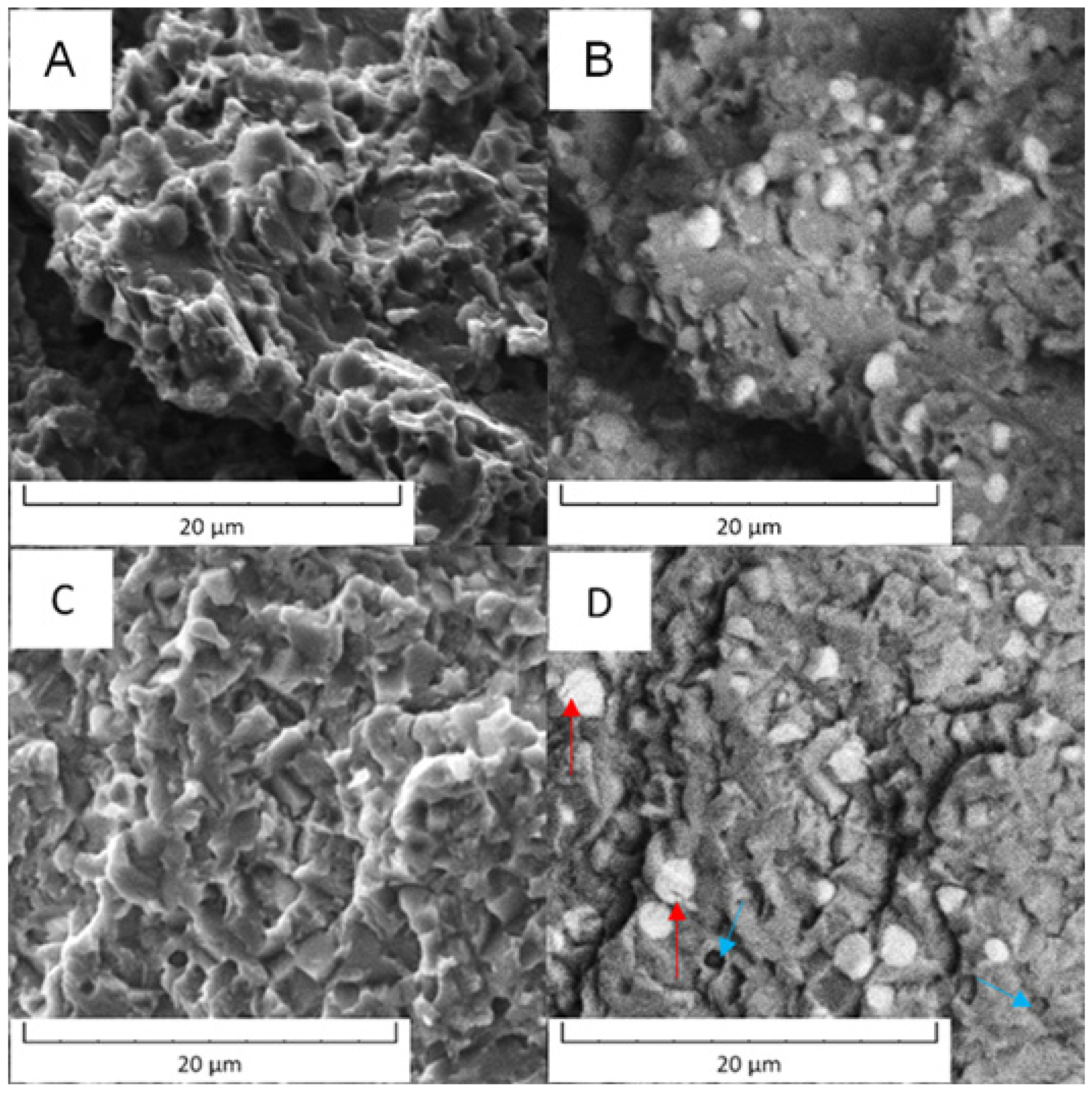
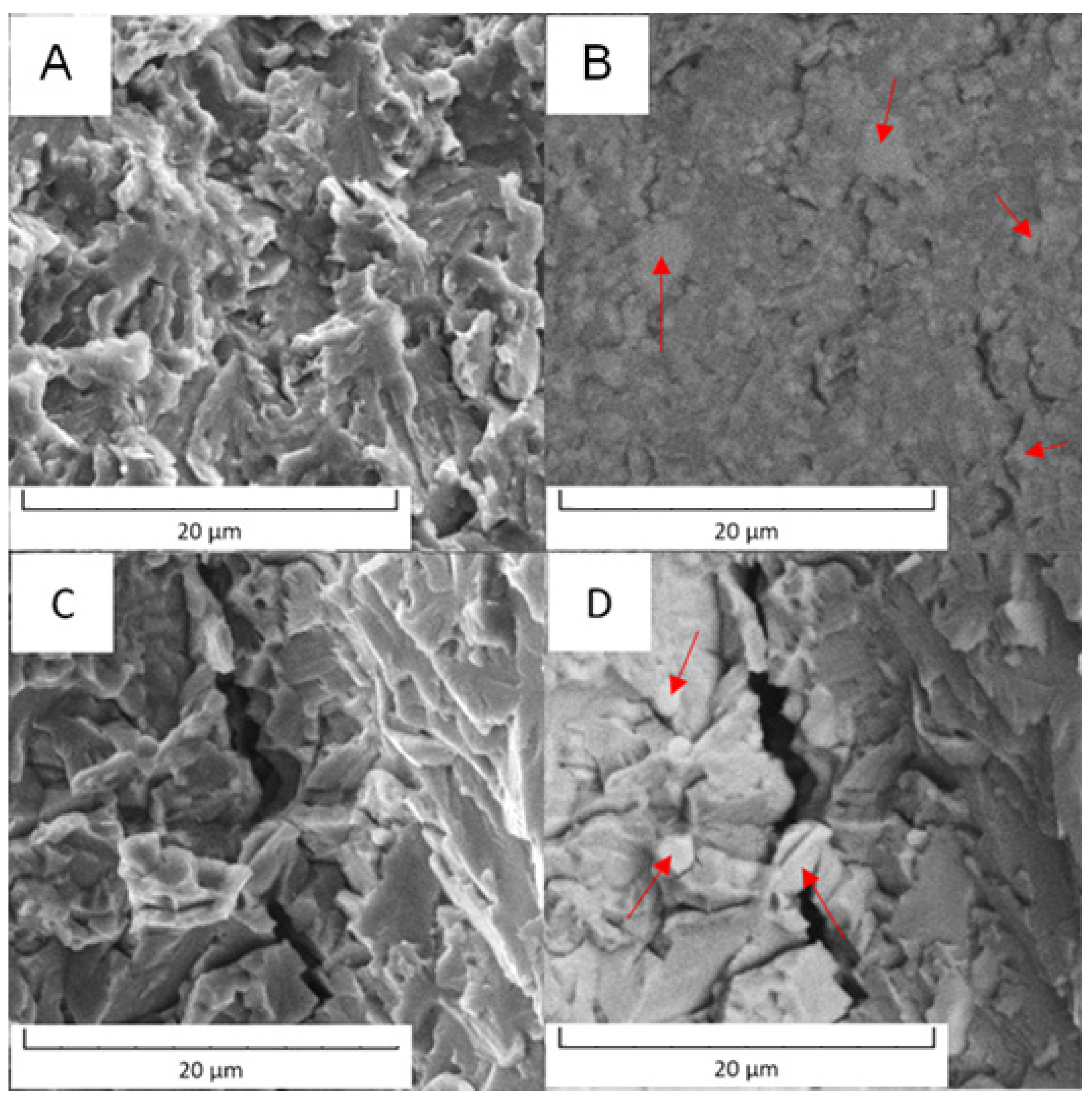




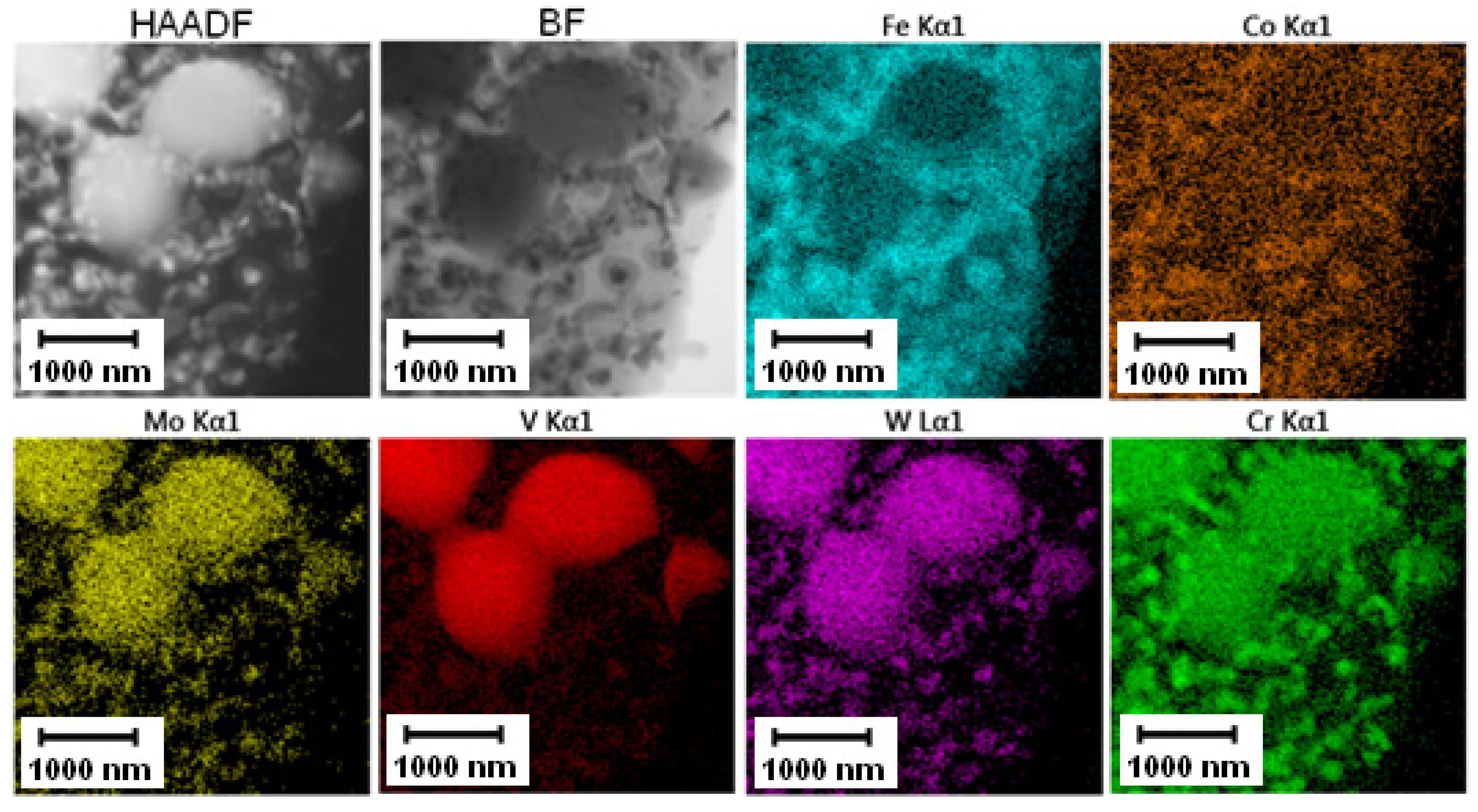
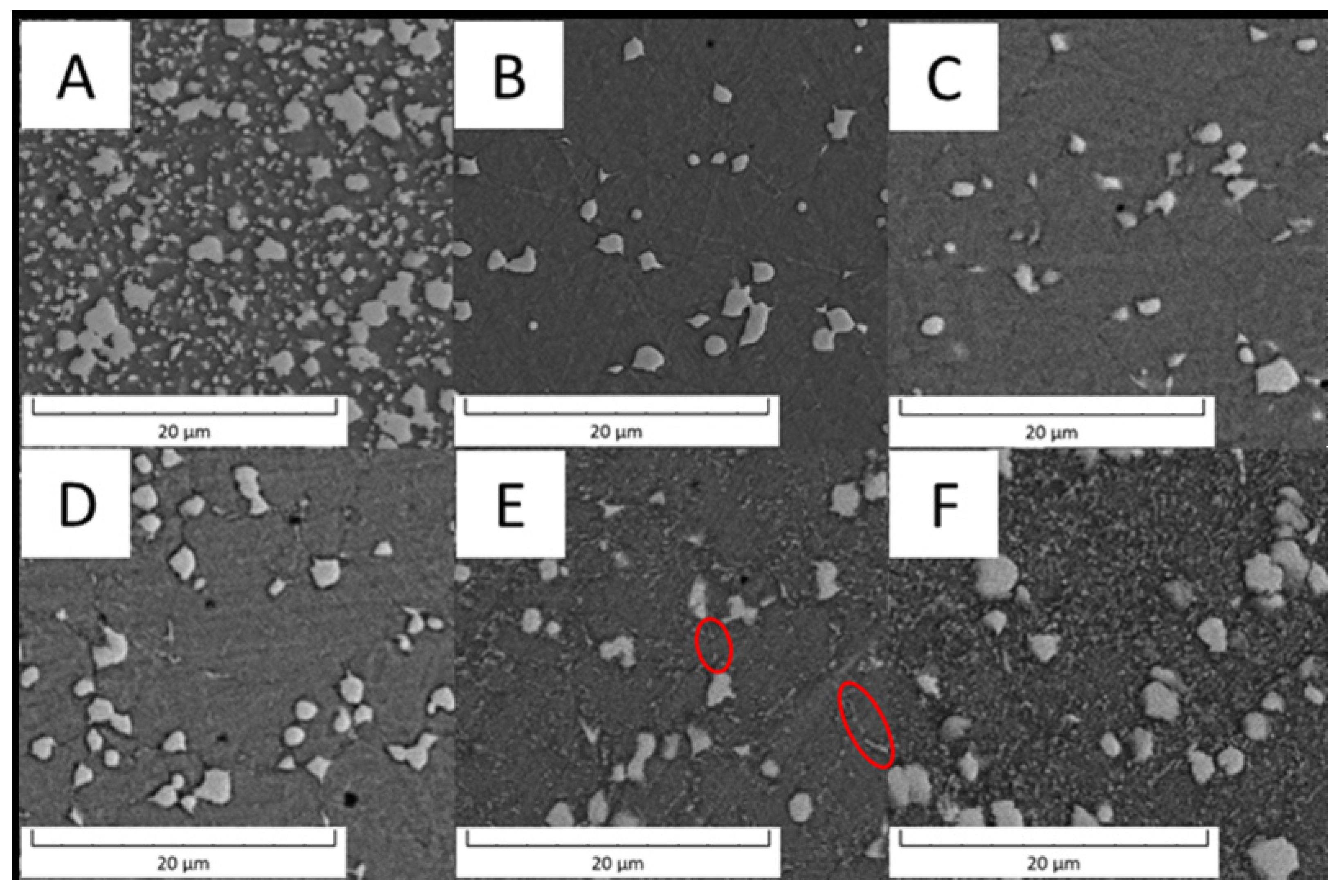
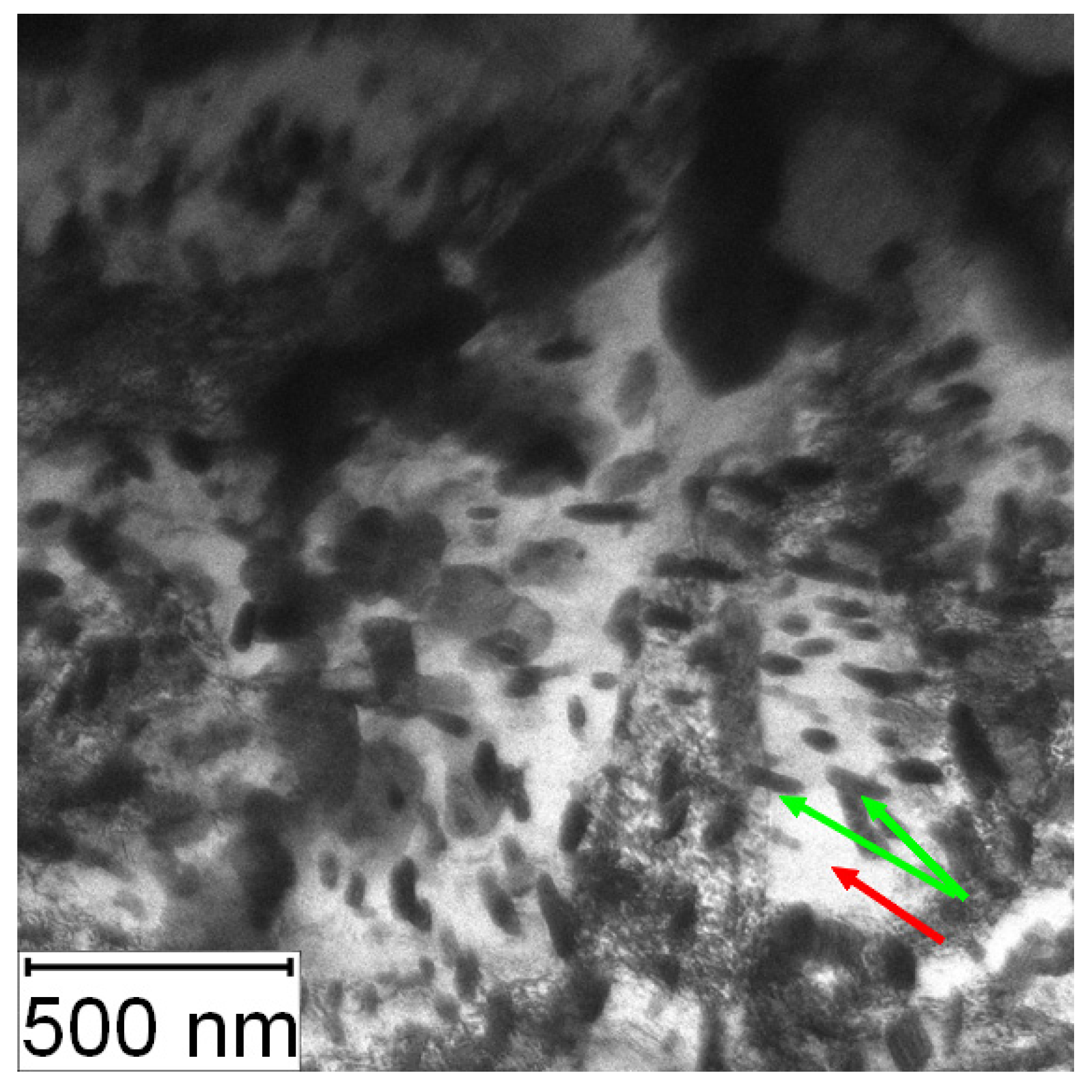
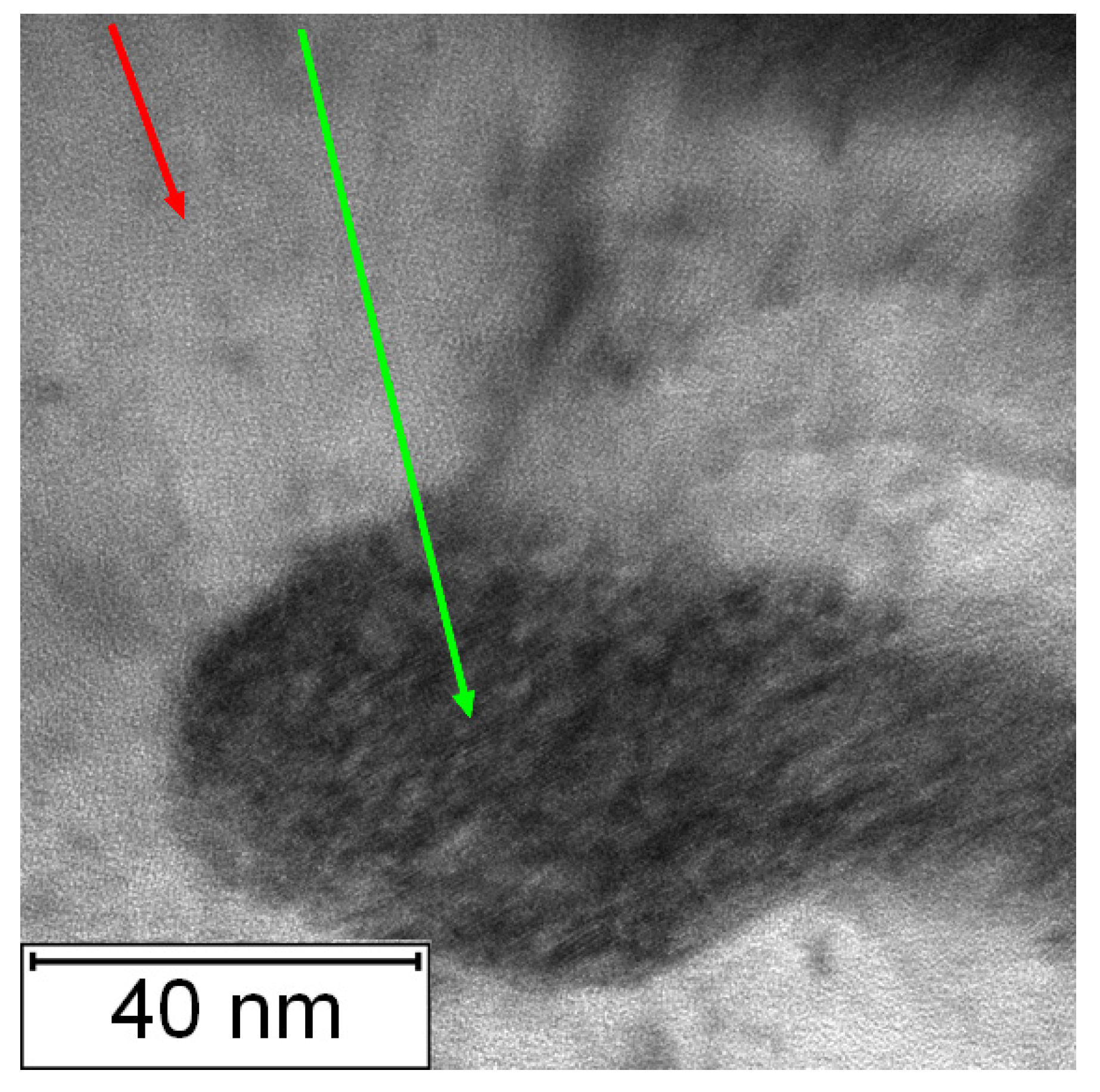
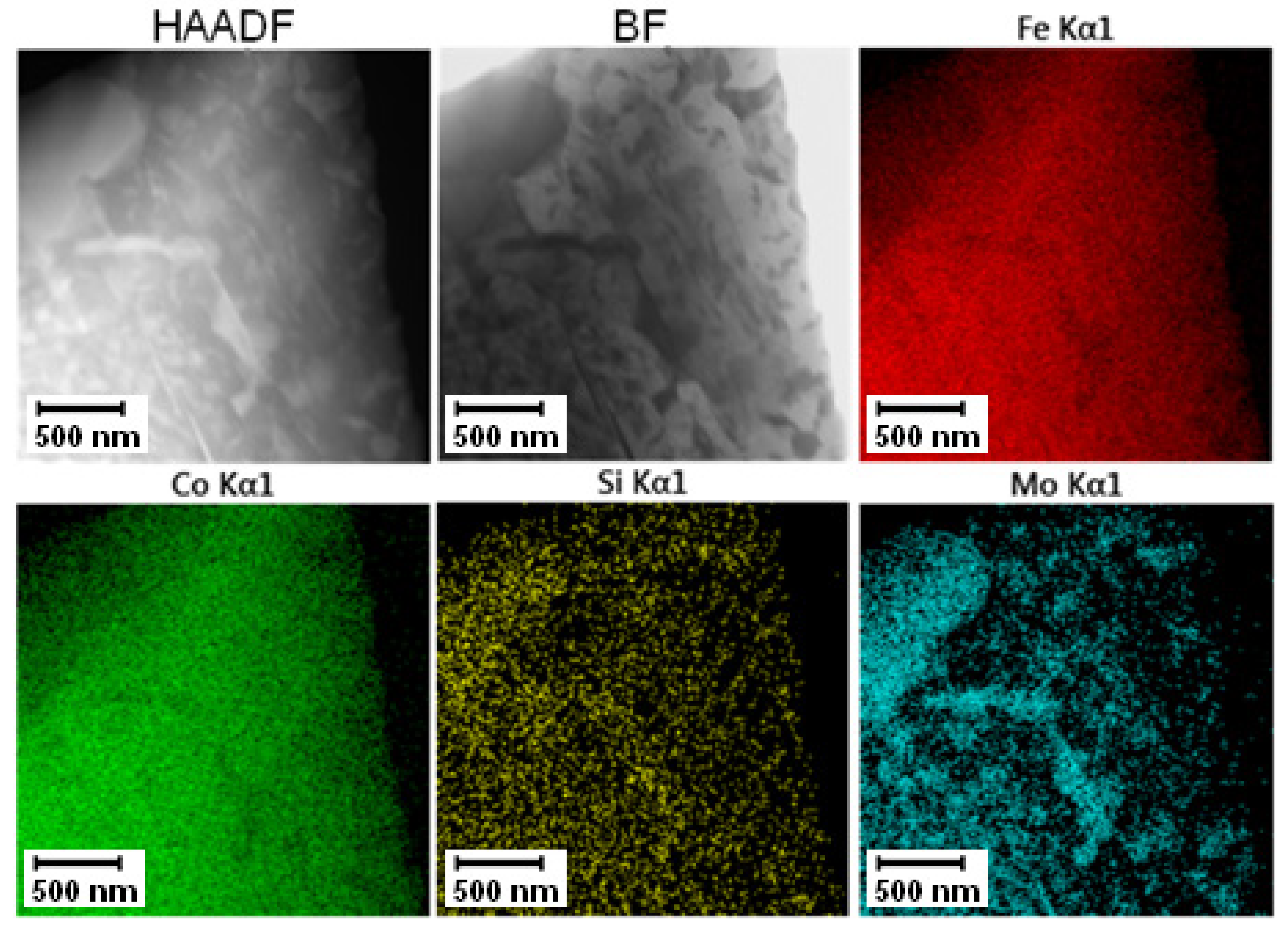
| Steel | Fe | C | Cr | Mo | V | W | Co | Si | Mn |
|---|---|---|---|---|---|---|---|---|---|
| Vanadis 60 | bal. | 2.3 | 4.3 | 7.0 | 6.5 | 6.5 | 10.5 | - | - |
| PM+ | bal. | 0.03 | 0.0 | 15.0 | 0.0 | 0.0 | 25.0 | 0.6 | 0.2 |
| Type of Particles | Soft State | HT State |
|---|---|---|
| Small dark | 0.5 ± 0.1 µm | Not observed |
| Large dark | 1.3 ± 0.3 µm | 1.4 ± 0.4 µm |
| Small bright | 0.4 ± 0.1 µm | Not observed |
| Large bright | 1.6 ± 0.4 µm | 1.6 ± 0.4 µm |
| Carbide | Fe | Cr | Mo | V | W | Co |
|---|---|---|---|---|---|---|
| Dark | 3.4 ± 3.1 | 5.6 ± 0.9 | 21.6 ± 1.6 | 43.7 ± 2.2 | 26.3 ± 2.0 | 0.1± 0.4 |
| Bright | 26.3 ± 0.7 | 3.2 ± 0.4 | 24.5 ± 1.6 | 2.7 ± 0.2 | 38.6 ± 2.7 | 4.6 ± 2.0 |
| Area | Fe | Co | Mo | Si |
|---|---|---|---|---|
| Particle | 37.3 ± 0.3 | 16.6 ± 0.2 | 44.3 ± 0.5 | 1.8 ± 0.1 |
| Matrix | 62.4 ± 1.2 | 25.1 ± 0.2 | 12.2 ± 1.2 | 0.5 ± 0.3 |
| Material | Sample Wear Rate/10−6 mm3/N/m |
|---|---|
| Vanadis 60 in the HT state | 1.815 |
| Vanadis 60 in the HT state after annealing at 600 °C/10 h | 4.01 |
| Vanadis 60 in the HT state after annealing at 650 °C/10 h | 2.19 |
| PM+ steel in the HT state | 5.4 |
| PM+ steel in the HT state after annealing at 600 °C/10 h | 7.1 |
| PM+ steel in the HT state after annealing at 650 °C/10 h | 11.0 |
Publisher’s Note: MDPI stays neutral with regard to jurisdictional claims in published maps and institutional affiliations. |
© 2021 by the authors. Licensee MDPI, Basel, Switzerland. This article is an open access article distributed under the terms and conditions of the Creative Commons Attribution (CC BY) license (https://creativecommons.org/licenses/by/4.0/).
Share and Cite
Michalcová, A.; Pečinka, V.; Kačenka, Z.; Šerák, J.; Kubásek, J.; Novák, P.; Vojtěch, D. Microstructure, Mechanical Properties, and Thermal Stability of Carbon-Free High Speed Tool Steel Strengthened by Intermetallics Compared to Vanadis 60 Steel Strengthened by Carbides. Metals 2021, 11, 1901. https://doi.org/10.3390/met11121901
Michalcová A, Pečinka V, Kačenka Z, Šerák J, Kubásek J, Novák P, Vojtěch D. Microstructure, Mechanical Properties, and Thermal Stability of Carbon-Free High Speed Tool Steel Strengthened by Intermetallics Compared to Vanadis 60 Steel Strengthened by Carbides. Metals. 2021; 11(12):1901. https://doi.org/10.3390/met11121901
Chicago/Turabian StyleMichalcová, Alena, Vojtěch Pečinka, Zdeněk Kačenka, Jan Šerák, Jiří Kubásek, Pavel Novák, and Dalibor Vojtěch. 2021. "Microstructure, Mechanical Properties, and Thermal Stability of Carbon-Free High Speed Tool Steel Strengthened by Intermetallics Compared to Vanadis 60 Steel Strengthened by Carbides" Metals 11, no. 12: 1901. https://doi.org/10.3390/met11121901
APA StyleMichalcová, A., Pečinka, V., Kačenka, Z., Šerák, J., Kubásek, J., Novák, P., & Vojtěch, D. (2021). Microstructure, Mechanical Properties, and Thermal Stability of Carbon-Free High Speed Tool Steel Strengthened by Intermetallics Compared to Vanadis 60 Steel Strengthened by Carbides. Metals, 11(12), 1901. https://doi.org/10.3390/met11121901







